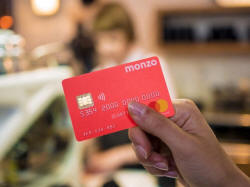Britain's digital banks: profitable or just popular?
 Send a link to a friend
Send a link to a friend
 [December 29, 2017]
By Emma Rumney [December 29, 2017]
By Emma Rumney
LONDON (Reuters) - British app-based bank
Monzo and others like it want to make money by allowing other firms
access to their customers rather than lending to them, but this is an
untested path to profitability.
Monzo's user numbers soared by 300 percent to 450,000 in nine months
this year, which has attracted investors and more than doubled its
valuation to $336 million.
The bank's distinctive coral-coloured card has become commonplace in the
wallets of the young and tech savvy.
But this growth has come at a cost: until recently every customer meant
a loss of 50 pounds ($67) as Monzo offered services such as overseas
cash withdrawals for free.
"The more you grow, the more you lose and you have to turn that corner
at some point," CEO Tom Blomfield told Reuters, referring to the moment
when each customer is no longer a loss to the bank. However he has no
target for overall profitability at Monzo.

Monzo and competitors like Starling Bank still largely steer clear of
the loans and hefty fees for overdrafts or foreign exchange that have
been so lucrative for existing banks, but which the newcomers see as
ripping off consumers.
Absorbing such costs has been expensive for some of the upstarts, but
they think they can make money from a new model based on using
customers' data to push them towards other financial services, taking a
commission whenever it works.
If successful, they could eat into the retail banking profits of the big
banks just as new rules are being introduced to reduce their dominance,
and returns are being shredded by tougher regulation and growing
competition.
They see the big banks' approach, built around lending out customers'
deposits at higher rates of interest, as costly. Capital requirements
are high, which would affect the way investors looked at the newcomers
if they took that route.
"Your business tends to get valued like a bank and not like Google,"
said Blomfield.
(For graphic on Digital banks' rise, click http://tmsnrt.rs/2BdERcZ)
THE 'MARKETPLACE'
The digital-only banks boast slick apps, which can analyze spending in
real time, send budgeting nudges and allow users to freeze and unfreeze
their card at the click of a button.
Aurelie Gonnage, a 25-year-old advertising producer, uses her Monzo
account to budget, pay friends easily and spend abroad without large
fees.
"I love the instantaneity of it," she said, although she wouldn't use it
as her main bank because it pays no interest on deposits and has no
branches to visit in an emergency.

But for the new banks, becoming central to users' lives is the key to
accessing the wealth of data needed to nudge them toward the right
products, and making money in the process.
"The important place in people's financial lives is where the data is,"
said Starling Bank CEO Anne Boden.
Partner firms plug into the apps, creating a "marketplace" of services
ranging from loans and investments to insurance and energy, and paying
the banks a fee whenever a customer signs up to their offering.
[to top of second column] |

A Monzo card in an undated photo. Courtesy Monzo/via Reuters

The banks will rely on this for income to varying degrees.
Boden said it will account for around a third of revenues at Starling, while
Monzo's Blomfield expects it to be the bank's main source of income in the long
term.
"The difficulty is you need massive scale and access to data to really make it
work," he said.
Achieving that could be difficult as others pursue similar strategies, said John
Cronin, head of UK banks research at analyst firm Goodbody.
Virgin Money also has plans for a marketplace, and HSBC is piloting a money
management app. Other big players are expected to follow suit in response to new
regulations forcing them to share their customer data with potential
competitors.
GROWING PAINS
The new banks' branchless, digital proposition means they benefit from far lower
costs.
Nevertheless, digital player Revolut, with a 300 million pound valuation and 1.2
million users, believes it couldn't achieve the scale it wants with marketplace
money alone.
Subscriptions for premium and business accounts resulted in 2.36 million pounds
of turnover in 2016 and Revolut plans to offer overdrafts and loans too. It
expects to break even by the end of 2018.Starling plans to hit the same
milestone one year later. Interest from overdrafts will provide a third of its
income, said Boden, with more funds coming from a business-facing payments
service and upcoming business accounts.
Monzo is also currently rolling out overdrafts and exploring one lending
product.

Edward Firth, managing director, UK banks at analysts KBW, said big banks make
such a good return on retail banking that the digital upstarts can halve it and
still make enough profit.
He has more confidence in models where the marketplace supplements such income,
rather than the other way around.
"It's still untested," he said.
Eileen Burbidge, partner at venture capital firm Passion Capital, which backs
Monzo, said the bank's rapid growth validates her confidence in its ethos and
model.
"That kind of engagement or interest from consumers is really unheard of in
financial services," she said.
Still, the firm wants Monzo to prove that each customer can drive more revenue
than they drive cost within a year or so.
Monzo has already halved the cost per user, although that has meant cutting back
on some key offers: previously unlimited overseas ATM withdrawals cost it 16
pounds per customer.
Now it will start adding revenues. Blomfield sees the marketplace playing an
increasingly important role, although he added: "Until it plays out it's hard to
know for sure."
(Reporting by Emma Rumney; editing by Giles Elgood)
[© 2017 Thomson Reuters. All rights
reserved.] Copyright 2017 Reuters. All rights reserved. This material may not be published,
broadcast, rewritten or redistributed.
 |